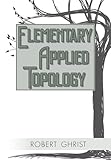Elementary applied topology
Material type: TextPublication details: Createspace Independent 2014 United StatesDescription: vi, 269 p. Includes bibliographical references and indexISBN:
TextPublication details: Createspace Independent 2014 United StatesDescription: vi, 269 p. Includes bibliographical references and indexISBN: - 9781502880857
- 514 G4E5
| Item type | Current library | Collection | Call number | Status | Date due | Barcode | Item holds | |
|---|---|---|---|---|---|---|---|---|
 Book
Book
|
Ahmedabad General Stacks | Non-fiction | 514 G4E5 (Browse shelf(Opens below)) | Available | 199781 |
Browsing Ahmedabad shelves, Shelving location: General Stacks, Collection: Non-fiction Close shelf browser (Hides shelf browser)

|

|

|

|

|

|

|
||
| 514 B7T6 Topology: a categorical approach | 514 E2C6 Computational topology: an introduction | 514 E2T6 Topology: a very short introduction | 514 G4E5 Elementary applied topology | 514 S4I6 Introduction to topology | 514 Z6T6 Topology for computing | 514.23 K2C6 Computational homology |
Table of contents:
1.1.Manifolds
1.2.Configuration spaces of linkages
1.3.Derivatives
1.4.Vector fields
1.5.Braids and robot motion planning
1.6.Transversality
1.7.Signals of opportunity
1.8.Stratified spaces
2.1.Simplicial and cell complexes
2.2.Vietoris-Rips complexes and point clouds
2.3.Witness complexes and landmarks
2.4.Flag complexes and networks
2.5.tech complexes and random samplings
2.6.Nerves and neurons
2.7.Phylogenetic trees and links
2.8.Strategy complexes and uncertainty
2.9.Decision tasks and consensus
2.10.Discretized graph configuration spaces
2.11.State complexes and reconfiguration
3.1.Counting
3.2.Curvature
3.3.Nonvanishing vector fields
3.4.Fixed point index
3.5.Tame topology
3.6.Euler calculus
3.7.Target enumeration
3.8.A Fubini Theorem
3.9.Euler integral transforms
3.10.Intrinsic volumes
3.11.Gaussian random fields
4.1.Simplicial and cellular homology
Contents note continued: 4.2.Homology examples
4.3.Coefficients
4.4.Singular homology
4.5.Reduced homology
4.6.tech homology
4.7.Relative homology
4.8.Local homology
4.9.Homology of a relation
4.10.Functoriality
4.11.Inverse kinematics
4.12.Winding number and degree
4.13.Fixed points and prices
5.1.Homotopy invariance
5.2.Exact sequences
5.3.Pairs and Mayer-Vietoris
5.4.Equivalence of homology theories
5.5.Cellular homology, redux
5.6.Coverage in sensor networks
5.7.Degree and computation
5.8.Borsuk-Ulam theorems
5.9.Euler characteristic
5.10.Lefschetz index
5.11.Nash equilibria
5.12.The game of Hex
5.13.Barcodes and persistent homology
5.14.The space of natural images
5.15.Zigzag persistence
6.1.Duals
6.2.Cochain complexes
6.3.Cohomology
6.4.Poincare duality
6.5.Alexander duality
6.6.Helly's Theorem
6.7.Numerical Euler integration
6.8.Forms and Calculus
Contents note continued: 6.9.De Rham cohomology
6.10.Cup products
6.11.Currents
6.12.Laplacians and Hodge Theory
6.13.Circular coordinates in data sets
7.1.Critical points
7.2.Excursion sets and persistence
7.3.Morse homology
7.4.Definable Euler integration
7.5.Stratified Morse theory
7.6.Conley index
7.7.Lefschetz index, redux
7.8.Discrete Morse theory
7.9.LS category
7.10.Unimodal decomposition in statistics
8.1.Group fundamentals
8.2.Covering spaces
8.3.Knot theory
8.4.Higher homotopy groups
8.5.Biaxial nematic liquid crystals
8.6.Homology and homotopy
8.7.Topological social choice
8.8.Bundles
8.9.Topological complexity of path planning
8.10.Fibrations
8.11.Homotopy type theory
9.1.Cellular sheaves
9.2.Examples of cellular sheaves
9.3.Cellular sheaf cohomology
9.4.Flow sheaves and obstructions
9.5.Information flows and network coding
9.6.From cellular to topological
Contents note continued: 9.7.Operations on sheaves
9.8.Sampling and reconstruction
9.9.Euler integration, redux
9.10.Cosheaves
9.11.Bezier curves and splines
9.12.Barcodes, redux
10.1.Categories
10.2.Morphisms
10.3.Functors
10.4.Clustering functors
10.5.Natural transformations
10.6.Interleaving and stability in persistence
10.7.Limits
10.8.Colimits
10.9.Sheaves, redux
10.10.The genius of categorification
10.11."Bring out number"
A.1.On point-set topology
A.2.On linear and abstract algebra
This text gives a brisk and engaging introduction to the mathematics behind the recently established field of Applied Topology. Over a century of development of principles and techniques in algebraic topology has of late crossed over to a variety of application domains. This text gives a completely novel introduction to these methods in the context of the applications. "Elementary Applied Topology" is short (250 pp. plus bibliography and index) and richly illustrated, with 268 figures. It is perfect for both self-study, and as the basis for a course in applied topology. This book is also well-suited for use as a supplementary text in a more traditional algebraic topology course, providing both context and motivation for the tools to be learned. The progression of mathematical techniques is a fresh approach. The book begins with a quick trip through manifolds and cell complexes. The segue to algebraic topology comes in the form of the Euler characteristic and the Euler calculus born from it. Passing from this to homology, exact sequences, and cohomology sets the stage for the innovative content to come. This is comprised of modern Morse theory (including discrete Morse theory, Conley index, and stratified Morse theory), sheaf theory (with an emphasis on cellular sheaves and cosheaves), and, finally, category theory and categorification. Every tool and topic is paired with an application. These range in scope across the biological, economic, engineering, material, physical, and statistical sciences. Of particular note are the applications to topological data analysis, including persistent homology and barcodes. "Elementary Applied Topology" is the first comprehensive text on applied algebraic topology for students of all mathematical sciences.
There are no comments on this title.

